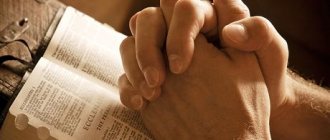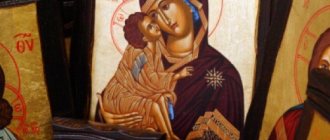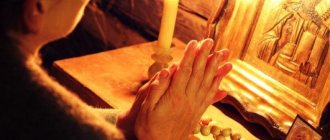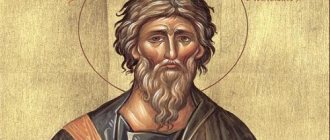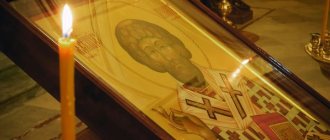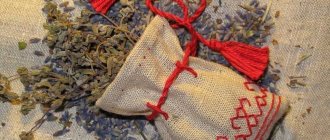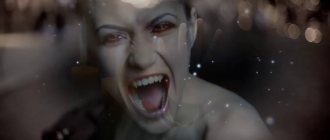After birth, every child must be baptized in church. After this ceremony, a guardian angel is assigned to him, who protects him throughout his life. But for complete protection, there must be icons in the house. They can be located either in the nursery or in any other room; this is not of fundamental importance. But many parents wonder: what kind of images should be in the house to protect their child? And it must be taken very seriously, since icons not only protect, but also from the first days of life strengthen the child’s faith in God, introducing him to Christianity. Let's figure out which images of saints should be hung in the child's room and where they should be located.
Icon of the patrons of the hearth, protecting from fire and enemies
An icon is not only an object of worship, charged with heavenly energy, it is a connecting link between man and God. It is important to understand that an unconsecrated image becomes only an internal object. The icon, after undergoing the ritual, will become a reliable protection for the house and the person from various misfortunes and bad energy. Do not place sacred images in your house, but do it with faith in your soul and with pure thoughts.
Icons, protection from storms, fire:
- Nikita Novgorodsky;
Nikita Novgorodsky
- Burning bush
Burning bush.
Protecting your home from thieves and enemies:
- Icon of Theodore Tyrone;
Theodore Tyrone
- Icon "Banner".
Icon of the Mother of God “The Sign”.
- John the Warrior;
John the Warrior
- Seven streams;
Seven feet icon with hands
- Ostra Brahmskaya icon;
Dawn Gate Icon of the Mother of God
There are certain rules for placing icons in a room:
- East side of the house.
- The place should be washed and crossed, do not move the images to find a better place.
- Walk through all the rooms with the icon in your hands before installing it.
- Do not hang pictures or other home decorations next to paintings.
- Do not place near televisions or music systems.
How to place icons at home
Traditionally, the images were located in the “red corner” (southeastern part of the house). The revolution of 1917 replaced the images of saints with portraits of leaders. During the Great Patriotic War, images of Saints began to gradually return to homes.
IMPORTANT! There are no clear rules for the placement of images of Saints in a room. It is not allowed to be placed in the bathroom, next to non-religious furnishings.
The place for icons should be free and accessible. This could be a wall, shelves, table. There may be candles, a prayer book, a lamp, and church books nearby.
Prayer for home protection
Prayer: Prayer to God can be either mental or spoken out loud. Most often this happens at difficult and turning points in life, when a person especially needs protection from above. Sometimes in a simple situation when we leave home for a while, concerns arise about the safety of our home and property. A pious person can turn to the saints during the service to feel the protective energy of the Almighty away from home. In such cases it is mentioned:
“Lord Jesus, Son of God! Protect my home from evil envy and evil people. Save My house from destruction and desecration and from fire. Save us from the abyss of sin. Joy in your home. Let Your will be done. Amen".
Before this, you must follow a certain ritual:
- Leave a card at the church about the health of your loved ones.
- Candles should be placed in front of the images of Jesus Christ, Blessed Matrona of Moscow, John the Warrior, Nikita of Novgorod.
- Buy holy water and twelve candles from the church.
- Light them in front of your home iconostasis.
- Wash yourself and your family with water from the church and sprinkle the corners.
- Bless your home when you leave it.
An icon that protects the family and helps in love
It is believed that a family is strong in faith, so every home should have icons in which one can find spiritual support in difficult times or show mercy to the Almighty. Family icons should be passed down from generation to generation, thereby making the connection to the clan a reality. These could be patron saints of houses, icons associated with important events, healings, or shrines preserved for generations. Such relics, which the ancestors prayed for, carry a powerful energy charge and are considered a strong talisman for the home and family. If such a relic has not survived, you need to go to the Orthodox Church and buy an icon, maybe it will become this family relic. God-fearing people know well the purpose of icons. Those who have just turned to God should learn about this. Icons as amulets of family and home:
- Iveron Mother of God.
Iveron Icon of the Iveron Mother of God
- Peter and Fevronia of Murom.
Peter and Fevronia
- Saints Joachim and Anna, father and mother of the Blessed Virgin Mary.
Joachim and Anna
- Martyrs Adrian and Natalia
Adrian and Natalia
- Samon, Gury and Abib are the patron saints of married women.
Patrons of married women
- “The Unfading Flower” is the guardian of family harmony.
"The Unfading Flower"
- The “Indestructible Wall” icon protects the family from difficulties and adultery.
"The Unbreakable Wall"
- Icon “Matrona of Moscow”: to guide you on the right path, to show a way out of a difficult situation.
Matrona of Moscow
Icons of the patroness of home and family will help preserve love, peace and harmony.
Use as amulets
The icon-amulet
Image is brought into the house to protect the family from exposure. Only those icons that are consecrated in the church carry power. Otherwise, it's just a piece of furniture. The believer treats images with love and reverence, reverence, and gives them a special place.
Properties of an icon as a talisman
- A person's attitude towards communication with God
- A reminder of the creation of the world, morality, ethics, the importance of leading a righteous life
- The power of healing, direction on the right path
Prayer for family happiness
Good relationships between loved ones are considered the main component of life. To extinguish outbursts of anger, establish inner harmony, and protect yourself from the evil eye, prayers addressed to the Almighty and patron saints are useful.
“Lord Jesus Christ, Son of God. Turn away our enemies from our family and cleanse us from envious defilement. If there is a struggle with demonic help, help me put an end to it. Grant us a peaceful life and free us from all the sins that we commit in ignorance. Thy will be done. Amen".
“Lord Heavenly Father! In the name of Jesus Christ, I pray to You for my marital happiness. Grant us in our family love for each other. Let our love strengthen and multiply. Teach me to love my spouse with all my heart and teach me to love him or her as You and Your Son Jesus Christ have loved me. Give me an understanding of what I need to remove from my life and what I need to learn so that we can have a happy family. Give me wisdom in my actions and words so that I never irritate or upset my spouse Amen.
What does the image look like?
The icon depicts the Mother of God with a baby sitting on her lap. Mary is dressed in a traditional maforia with stars symbolizing her purity. The love-filled gaze of the Mother of God is usually focused on the Divine Son, but in some versions she looks at the person praying.
Baby Jesus here is just a child. He does not bless or hold the Gospel, but trustingly clings to his mother. The same type includes the “Leaping of the Baby” icons, in which Jesus strokes his mother’s cheek with his hand.
A feature of icons of this type is the complete absence of distance between the Mother of God and the Savior. They cling to each other, which symbolizes the boundless love and trust between them. However, the mother’s gaze already expresses some sorrow: she anticipates the trials prepared for her Divine son.
A classic of this iconographic type is the half-length image of the Ever-Virgin. However, there are shoulder-length and even life-size icons of Eleusa. And some icons, although called “Tenderness,” are not Eleus.
Let's get acquainted with the most famous Tenderness icons that have survived to our times.
Vladimirskaya
According to legend, the first icon of this type was painted by the Evangelist Luke. Some believers claim that the icon of the Vladimir Mother of God kept in Russia is the same image from Luke.
However, the results of the research convince us that the Vladimir Icon was painted around the 12th century, so it cannot possibly be by Luke. Nevertheless, the Mother of God of Vladimir is the most ancient image of this type that has come down to us, residing in Russia.
The Vladimir icon was brought to Rus' in 1131 straight from Constantinople as a gift to Prince Yuri Dolgoruky. Then his son, Andrei Bogolyubsky, transported the icon to Vladimir, where it received its name. In the 14th century, the image came to Moscow, from where it subsequently left only for a short time.
The Vladimir icon is considered the protector of Russia, and naturally: many miracles are associated with it, including the expulsion of invaders from Russian lands. For example, she took part in saving Moscow from the troops of Tamerlane, the Horde member Akhmat, the Crimean Makhmet-Girey, and so on.
The Icon of the Vladimir Mother of God became the prototype of many copies, some of which (Volokolamsk, Seliger, Oran and others) are revered as miraculous. A distinctive feature of these images is truly God’s tenderness - Christ’s miniature foot (“heel”) turned towards the viewer.
The wonderful image survived decades of godlessness and is now in the Church-Museum of St. Nicholas at the Tretyakov Gallery. The miraculous icon continues to protect Rus' and heal the suffering to this day.
The main distinguishing feature of the prototype is the presence of an image on the back. There is displayed the “prepared throne” and the instruments of the passions. This is a later image, presumably by Andrei Rublev.
Pskov-Pecherskaya
The Pskov-Pechersk Icon of the Mother of God is considered a copy from the Vladimir Icon. Perhaps this is so, but a fundamentally different, later school can be traced here. In principle, the plot of the prototype is completely preserved, down to the poses and facial expressions, but the painting style itself is much more realistic.
According to historical chronicles, the Pskov-Pechersk Icon was painted in 1521 by the monk Arseny Khitrosh. Almost immediately she was transferred to the Pskov-Pechersk monastery, where her miracles have been chronicled since 1524.
The main “specialization” of this image is the restoration of vision - a special book describes several cases of miraculous healing from blindness. However, cases of recovery from other ailments, such as paralysis, have also been recorded.
This image was prayed to during enemy invasions. Believers believe that it was the Pskov-Pechersk Mother of God who contributed to repelling the attacks of the troops of Stefan Batory and Napoleon Bonaparte.
Pskov-Pechersk Mother of God in the Pskov-Pechersk Lavra
The Pskov-Pechersk Lavra has long been a stronghold of Orthodoxy. It did not stop working not only during the years of Soviet power, but even during the Great Patriotic War, when it was practically destroyed by bombing. It is believed that the Mother of God covered this holy place with her protective cover.
Now the image of the work of monk Arseny is in the main chapel of the Assumption Church of the Pskov-Pechersk Lavra. And St. Michael’s Church received a list, which later became revered.
"Recovery of the Dead"
The image of “Seeking the Lost” became famous for its numerous miracles. Particularly eloquent are the cases when the Mother of God saved people who were on the threshold of death, and sometimes even those who crossed it.
The history of the icon begins with an incident that took place in the 17th century near the town of Bor, Kaluga province. The peasant Fedot Obukhov was returning home for Epiphany, but was caught in a strong blizzard. Fedot was already freezing, but half-forgotten he prayed to the Blessed Virgin and promised to create an icon of the Mother of God for the parish church in honor of his own salvation.
At this time, another peasant heard a voice from the street saying, “Take it.” He decided to find out what was wrong, went out into the yard and saw a sleigh, and in it, the dying Fedot. The peasant warmed up, recovered over time and was not slow in keeping his promise. This is how the Borovsk Icon of the Mother of God appeared, which quickly became famous as miraculous.
Several lists were immediately made from the wonderful image. Subsequently it turned out that they inherited the wonderful properties of the prototype. For example, an icon from the village of Malizhino vigilantly protected parishioners from cholera.
The wonderful story of another list, originally in private hands, is also striking. It was owned by a parishioner from Moscow. This man lost his wife, fell into poverty, and was left with marriageable daughters.
Fervent prayer to the icon helped the Christian get out of poverty and arrange the fate of his daughters. He considered this a miracle of God and took the miraculous image to the Church of the Resurrection of the Word, which is on the Assumption Vrazhek.
The miraculous image of the “Recovery of the Dead” suffered from vandalism by the occupiers during the Napoleonic War - it was literally split into several parts. However, it was lovingly restored and left in the Resurrection Church on the Assumption Vrazhek, where it remains to this day.
Serafimo-Diveevskaya
Before us is the favorite icon of Seraphim of Sarov. The Monk Seraphim singled out this image among similar ones and prayed to it tirelessly. Even if he left his cell somewhere, he carried this icon with him.
Seraphim of Sarov was revered as a miracle worker during his lifetime, and his favorite icon helped him in creating many miracles. Suffering people came to him from afar, Seraphim anointed them with oil from a lamp that burned in front of the image - and the sick were healed!
Seraphim died at a very old age, in front of his beloved icon, which he himself called “The Joy of All Joys” (later the icon was called “Seraphim’s Tenderness”). He bequeathed the image to the Diveyevo convent, which he patronized throughout his life.
Silver pendant “Icon of the Mother of God “Tenderness”” (go to the SUNLIGHT catalog)
After the revolution, the Seraphim-Diveevo Monastery was closed, the nuns were dispersed, and the miraculous image was taken away. He traveled a lot to churches, until, in the end, he ended up in the personal residence of the Patriarch of the Russian Orthodox Church. Now every year, on the day of the Praise of the Mother of God, the icon is taken to the Epiphany Church, so that everyone who suffers can ask for healing, quenching sorrows and strengthening faith.
The Seraphim-Diveyevo icon is not the classic Eleusa. She is, rather, a close relative of the Ostrobramskaya Mother of God from Vilnius, who is revered by both Catholics and Orthodox Christians. “Tenderness” in this case is not a reference to an iconographic type, but the personal name of the icon.
There is no image of the baby Jesus on the icon for a simple reason: he has not yet been born. The Ever-Virgin is depicted at the moment when she learned the Good News about the upcoming birth of the Savior.
Despite the fact that in the temple of the restored Seraphim-Diveyevo monastery there is a late copy of the “Seraphim Tenderness”, it is revered no less than the sacred prototype.
Lokotskaya
The Lokot myrrh-streaming icon “Tenderness” is eloquent evidence that miraculous images appear in our days. Moreover, they are not necessarily created by icon painters in compliance with all canons.
The Lokot icon is a reproduction of the image of “Seraphim’s Tenderness”, cut out from an expired calendar. Dentist Natalya Murashkina bought this calendar out of pity and piety, only to prevent the desecration of the shrine.
Natalya brought the calendar home, cut out the icon and hung it on the wall. Imagine her surprise when the icon began to bleed myrrh, and on its back a miraculous image of the Mother of God appeared!
Nowadays the Lokot icon is one of the main shrines of the Orthodox world. On some days, she not only streams myrrh herself, but also causes myrrh to stream in other images. A special frame was made for her so that the wonderful image could be seen from both sides.
Gold pendant “Vladimir Icon of the Mother of God” (go to SUNLIGHT catalogue)
Icon bringing happiness and prosperity to the family
Every family has its own definition of happiness. It may happen that happiness will outgrow your family vessel, and misfortunes will come one after another. To gain the fortitude to overcome adversity, you need to turn to the holy benefactors:
- Wonderworker Spyridon of Trimifuntsky - helps in solving material problems.
Icon of Saint Spyridon of Trimythous
- The Great Martyr of Triphunta John the Merciful prays for prosperity and stable well-being. In ancient times, this icon was turned to during times of mass famine.
Icon of the Great Martyr Tryphon
Prayer for prosperity and prosperity
“Money doesn’t buy happiness,” the saying goes, and this, of course, is partly true. But every family or person would like to have a stable income and material wealth. Difficulties with money often cause family discord, housing problems, and money is often used to solve health problems. To attract wealth, you need to turn to the saints:
- Spyridon of Trimifuntsky;
- Tikhon Zadonsky;
- Xenia the Blessed;
- John the Merciful;
The powers of the Almighty, of course, will not solve material difficulties. But they will help focus your internal reserves, strengthen your spirit, and the Lord and Saints will direct your energy in the right direction.
“Heavenly Father, thank You for all the good things You give me through Jesus. Savior, bless the work You have given me. Give me strength to do my work for the good of Your Kingdom. Give me the joy of seeing the fruits of my labor and my sacrifices. Fulfill in me Your words: “It is more blessed to give than to receive,” so that I can live in abundance and not experience poverty. And if I fall into poverty, grant me, Almighty, wisdom and patience, so that I can bear it with dignity and without reproach. Amen".
Strong icons against diseases
How often do people not think about the fact that being healthy is happiness. Such thoughts begin to appear when illnesses occur to loved ones. This may be the result of wasteful treatment of the body, unfavorable environment or accidents. Medicine in our time has reached unprecedented heights, but sometimes turning to the Almighty is our only hope. There are many known cases of miraculous healings through prayers in front of images of saints or God. Medicine cannot cure diseases caused by the evil eye or damage; only a word addressed to the Almighty can help:
- The main icon that helps get rid of torment is the image of Christ. The Savior went through terrible torment, so He understands the suffering of a praying person.
- The Virgin Mary "Our Lady of Hope" is revered by people as one of the most miraculous icons.
Icon of the Mother of God “Our Lady of Mercy”.
- The icon of the Mother of God “St. Panteleimon” is the patron saint of people experiencing physical torment. The icon is placed among patients and they pray over it before complex operations.
Saint Panteleimon
Feast of the Tenderness Icon
The day of celebration is individual for each icon. Moreover, each image can have several general dates of veneration, and there are also local holidays for specific lists.
It is almost impossible to give a complete list of memorable dates, so we will dwell only on the holidays of the most revered images:
- Vladimirskaya - June 3, July 6, September 8;
- Pskov-Pecherskaya - all holidays of the Vladimir Icon plus October 20 and June 5 (transitionable);
- “Recovery of the Dead” – February 18;
- Serafimo-Diveevskaya - August 1 and August 10;
- Lokotskaya - so far like the Seraphim-Diveevsky image.
Prayer for Healing
The divine word to God can work miracles. The most important thing is that faith is in the soul and thoughts are clear, then the Lord will not leave a person alone in pain and suffering. Prayers for health for the sick are very powerful. The most important thing is that he be baptized. You can pray for health with the following prayer:
“Oh, our Creator! I ask you for help. Grant, by Your mercy, complete healing to the servant of God (name), wash his blood with Your rays. Only from Your merciful help will his healing come. Touch him with Your wonderful power, give his body health, his soul blessed lightness, and his heart Your balm. May the pain depart from him forever, and his strength will return, and his wounds will be healed, and Your holy help will come. May Your rays give him strong protection and strengthen his faith. Lord Almighty, hear my words. Amen".
How to pray to an icon correctly
Believers pray in the morning and before going to bed, before eating and after eating, before starting a task and at the end of it. Discipline and regularity are important.
In prayer, the attitude is important.
The spiritual attitude is important;- Prayer should be directed towards the image;
- You must approach the image, bow and cross yourself;
- You can read prayers by heart, you can use a prayer book;
- When reading a prayer, faith in divine power and help is important;
- It is possible to read prayers according to prayer books and akathists;
Icons protecting children
The child is pure and sinless and therefore is under the special protection of the Almighty. He remains under the “wings” of the Guardian Angel, the Savior Himself and the Blessed Virgin Mary. Icons of amulets for children:
- Stylian of Parthagon is the patron of children who are about to be born. Women suffering from infertility pray to him.
Stylian of Parthagon
- Saint Nicholas the Wonderworker.
- Icon of Gabriel of Bialystok
Gabriel from Bialystok
Badges are placed in rooms where children are most often found.
Prayer for the health of the child
There is nothing stronger than a mother's prayer for her child. Our prayers are sincere and full of faith. You need to know that in moments of grief and when turning to higher powers you should not make empty promises. Before prayer, go to the temple and write a card for the health of your child. Place candles in front of the icons of the Mother of God, Christ and the Saint. Ask for forgiveness for personal shortcomings and pray for the health of God’s servant, name the child’s name, and say “Child of God” until the age of seven.
Bring home blessed water, place your hand on the child's head, say a prayer and wash the child.
You can also use your own words, and above all with hope in your soul, to turn to the heavenly powers for healing.
“O Mother of God, protect and protect my children (names), all young men, girls and children, baptized and unbaptized, as well as those who are carried in the womb. Cover them with the robe of Your motherhood, keep them in the fear of God and in obedience to their parents, ask My Lord and Your Son to grant them what is useful for their salvation. I entrust them to Your maternal gaze, for You are the Divine protection of Your servants. Amen".
Venerable Stylian of Paphlagon, Intercessor of Children
Born in Asia Minor, in the city of Paphlagonia in the 5th century. From childhood, he strove for a holy, righteous life, avoiding harmful temptations.
After Saint Stylian came of age, he distributed his property to the poor with the words: “I threw off the heavy anchor that kept me tied to the desires of my fallen body. From now on, the path to true life is open to me.”
After this, he became a monk in one of the monasteries. He led a very harsh, ascetic lifestyle and became famous for the virtues of purity and obedience.
Wanting to be closer to God, he went into the desert and settled in a cave. He spent days and nights in prayer.
The Lord, seeing Stylian’s ardent desire to preserve childish faith and purity in his soul, gave him the grace of protecting children. While he was alive, mothers from different villages came to him in the desert so that he could cure their children of illness. Saint Stylian asked God for healing and always received it for the child.
Infertile families received children through the prayers of the saint. After the death of Saint Stylian, barren women asked his image for healing and received it.
Saint Stylian reposed at a ripe old age. And now temples are consecrated in his honor in Asia Minor, Greece and Cyprus. On the icons he is depicted holding one or more babies in his arms.
Source: Shutterstock
Icon asking for marriage
Marriage in Orthodoxy is considered not only the creation of a family for the purpose of reproduction, but also the spiritual union of a man and a woman. The need to find a husband worthy of being a wife is a natural phenomenon. There is nothing unnatural about asking saints for help. Such prayers are addressed to icons:
- Great Martyr Paraskeva Pyatnitsa is the patroness of girls, helping to create a family of love. Protects against female diseases.
Paraskeva
- The wonderful Feodorovskaya icon.
Feodorovskaya icon
- Icon "Flower of the Ever-Virgin".
- The icon “Nicholas the Wonderworker” comes to the rescue not only in life’s difficulties, but also in a successful marriage.
- Icon of St. Andrew the Wonderworker, to whom parents pray for their daughters.
Saint Andrew
- Matrona of Moscow.
- Saint Seraphim of Sarov - helps mature women.
Saint Seraphim of Sarov
Saints - patrons of children
Orthodox Christians often seek to offer special prayer for their children. Sincere prayer always reaches God, no matter through whom it is addressed to Him. And yet, there are saints to whom we pray for children more often than others.
The Blessed Virgin Mary and the parents of the saints
Of course, the first intercessor before God for our children is the Most Holy Theotokos, the Mother of our Lord Jesus Christ. She always takes to heart the experiences of mothers and fathers for their children and prays to the Savior for them.
Some icons of the Mother of God, for example, “Mammal” or “Helping Childbirth,” are especially dedicated to childbirth and the unity of a child with his mother.
Also, other holy parents who at one time managed to raise their children in love and reverence for the Almighty have special grace in prayer before the Lord for our children: the righteous Joachim and Anna, the righteous Zechariah and Elizabeth, the Venerable Cyril and Mary of Radonezh, the forefathers Abraham and Sarah. , royal passion-bearers Nicholas and Alexandra.
Among the huge number of other saints, several more ascetics stand out, whose lives were connected with caring for children and to whom we can also turn with prayer for them. Let's try to remember them together.
Venerable Stylian of Paphlagon, Intercessor of Children
The future monk was born in the city of Adrianople in Paphlagonia (Asia Minor) in the 5th century. From childhood, he showed a rare desire for a holy life and always kept his soul pure and avoided harmful temptations.
Having reached adulthood, Saint Stylian distributed all his property to the poor, saying the following words: “I threw off the heavy anchor that kept me tied to the desires of my fallen body. From now on, the path to true life is open to me.”
After this, Saint Stylian became a monk in one of the Asia Minor monasteries. Thanks to severe asceticism, Saint Stylian acquired the virtues of non-covetousness, purity and obedience.
Wanting to be even closer to God, he went into the deserted desert, where he settled in a cave. For several years he spent days and nights in prayer and praise to God. The words of the Savior entered Stylian’s heart deeply: “Truly I tell you, unless you are converted and become like children, you will not enter the Kingdom of Heaven” (Matthew 18:1-4).
The Lord, knowing about Stylian’s ardent desire to acquire a child’s faith and purity, gave him the grace of protecting children.
Mothers walked through the desert for days from nearby towns and villages, bringing him their sick children for healing.
Saint Stylian took the child into his mother’s arms, tearfully asked God for healing, and certainly received it.
Through the prayers of the saint, infertile families found their maternal and paternal happiness. After the death of Saint Stylian, barren women who prayed at his image also often received healing.
Saint Stylian reposed in the Lord at a very old age and was revered throughout the Christian world. In Asia Minor, Greece and Cyprus, temples are consecrated in his honor. On icons the saint is depicted holding one or more babies in his arms.
Saint Nicholas, Archbishop of Myra of Lycia, Wonderworker
Saint Nicholas was born in the 3rd century in the Lycian city of Patara, of which his uncle was the bishop, into a Christian family and was raised by his parents in faith and piety.
The saint's family was very wealthy, and after the death of his parents he received a large inheritance. However, by this time he decided to devote his life to God and became the archbishop of Myra in Lycia, so he gradually distributed the wealth he received to those in need.
During the period of persecution of Christians instituted by the Emperor Diocletian, Saint Nicholas was imprisoned, where he experienced many hardships, but escaped execution. After the accession of Emperor Constantine the Great, the saint was released.
Then the saint participated in the First Ecumenical Council, which condemned the heresy of the false teacher Arius that God the Son is not consubstantial with God the Father and is “lower than Him,” since he was created by God the Father. According to legend, at the Council the saint struck Arius for blaspheming God, but through the miraculous intercession of the Mother of God he was forgiven by the fathers of the Council, who were going to deprive him of his episcopal dignity for this.
The saint performed many miracles and good deeds during his life, many of which touched children.
So, one day Saint Nicholas passed by the house of a poor man who had three unmarried daughters, and learned that the poor man was going to sacrifice the honor of the girls in order to receive at least some funds for their dowry.
Then Saint Nicholas, under the cover of darkness, threw a bundle of gold out the window. Soon the poor man managed to marry off his eldest daughter. In the same way, the saint blessed the family twice more, so that the daughters would find family happiness, and their father, driven to despair, would avoid sin.
In ancient times, on the day of remembrance of the saint, parents gave gifts to their children, and at churches they were given sweets. Therefore, the saint served as the prototype for such a Christmas character as Santa Claus, who on Christmas night brings gifts to children on a reindeer sleigh.
Saint Nicholas peacefully departed to the Lord in old age, around the middle of the 4th century. In 1087, his relics were transported from Myra Lycia to the Italian city of Bari, where they rest today in the crypt of the cathedral, erected in honor of the saint in the 12th century.
Hieromartyr Thaddeus of Tver (Uspensky)
The future saint (Ivan Uspensky), glorified among the host of holy new martyrs and confessors of the Russian Church, was born on November 12, 1872 in the village of Naruksovo, Nizhny Novgorod province, into the family of a priest with many children.
In 1892 he graduated from the Nizhny Novgorod Theological Seminary, after which he entered the Moscow Theological Academy, during which he decided to become a monk and was ordained a hieromonk.
After graduating from the theological academy, Hieromonk Thaddeus was engaged in scientific works, taught in several seminaries and paid a lot of attention to the internal personal development of his students, until in 1908 he was ordained a bishop.
Archbishop Thaddeus (Usensky) was engaged in teaching activities for many years. In his pedagogical works, he explained the meaning and methods of spiritual and moral upbringing and education.
His main final work on pedagogy and education is published in his works on education.
In addition, he also wrote such a wonderful work as “Notes on Didactics,” where, based on the patristic tradition, he speaks about the need to develop in a child not only and not so much the mind, but even moreover, morality and will, because the mind without them it can be turned into evil.
The saint notes that education without upbringing is impossible, and the education of the individual, which continues throughout life, should not stop at school, but only intensify.
In 1917, the saint was first arrested by the Bolsheviks and from that time on he periodically found himself in various prisons and exiles. In 1923, Vladyka headed the Astrakhan See, where he put in a lot of work to overcome the renovationist schism.
In March 1928, Archbishop Thaddeus was, after yet another arrest, appointed to the Tver See, where he spent the last years of his confessional life, which ended in martyrdom.
In December 1937, Bishop Thaddeus was executed by the Bolsheviks. There were rumors that he was drowned in a pit of sewage. After the death of the bishop, believers secretly opened the grave and reburied the relics of the saint, which were again discovered only in 1993. Today they are in the Tver Ascension Cathedral.
Priest confessor Nikolai Lebedev
Hieroconfessor Nikolai was born in 1869 in the village of Berezhai, Tver province, into the family of a poor sexton, Vasily Lebedev.
At public expense, he graduated from the Tver Theological Seminary with honors and entered the church as a psalm-reader in the village where his father once served. Here he stayed for six months and in 1894 he was ordained a priest at the Church of the Kazan Icon of the Mother of God in the village of Vlasyevo, located several miles from Tver.
Immediately after the start of service in the Kazan Church, Father Nikolai began to educate his parishioners in the spirit of the Orthodox faith and tried to eradicate their vices.
He became the organizer and founder of the Vlasevsky Kazan Temperance Society in Tver, the organizer of workhouses, like those founded by the holy righteous John of Kronstadt, and the editor and publisher of the magazine “To the Light” (1909–1917).
The active priest was especially attentive to the fate of children and organized an orphanage to help children from poor families. The shelter was opened in the fall of 1907 on the day of the celebration of the Kazan Icon of the Mother of God.
About 40 children studied the school curriculum and handicrafts with him: boys weaved baskets, and girls sewed shirts and dresses for the children of the orphanage. Children were also accustomed to agricultural work.
In the settlements under his jurisdiction, Father Nikolai achieved the closure of all taverns and, with the help of local residents, opened two schools and several teahouses with reading rooms, literary readings and “foggy pictures”.
The priest began to be subjected to arrests literally from the first years of Soviet power: in 1918 and 1921, but for a short time. In 1929, he was arrested again and sentenced to three years in the camps (Solovetsky Special Purpose Camp), and then exile to Komi.
After the end of his term in prison, the priest was not released, and he died in exile in the village of Korchemya, Ust-Kulomsky district of Komi, “from stomach pains.” He was buried here in an unknown grave.
Hieroconfessor Nikolai Vasilyevich Lebedev (not to be confused with Hieromartyr Nikolai Andreevich Lebedev) was canonized as the Holy New Martyrs and Confessors of Russia at the Jubilee Council of Bishops of the Russian Orthodox Church in August 2000.
Venerable Martyr Elisaveta Feodorovna (Romanova)
The Reverend Martyr Grand Duchess Elizabeth was born on October 20, 1864 into the Protestant family of Duke Ludwig IV of Hesse-Darmstadt and Princess Alice, daughter of Queen Victoria of England. In 1884, she married Grand Duke Sergei Alexandrovich, brother of Emperor Alexander III.
Seeing the deep faith of her husband, the Grand Duchess voluntarily and sincerely converted to Orthodoxy. In the same year, Grand Duke Sergei Alexandrovich was appointed Governor-General of Moscow.
The Grand Duchess tried to share the responsibilities of her husband-city ruler and visited churches, hospitals, orphanages, nursing homes and prisons, where she tried to do charity and provide assistance, and during the years of the Russo-Japanese War she helped the front and wounded Russian soldiers.
On February 5, 1905, her husband was killed by a terrorist bomb, and Elisaveta Feodorovna, having mourned her husband, decided to create a monastery of labor, mercy and prayer in Moscow.
She bought a plot of land with four houses and a vast garden, where she built two churches and a monastery of mercy with a hospital, pharmacy, orphanage and school, named after the holy sisters Martha and Mary.
Outside the walls of the monastery, a house-hospital was also built for women suffering from tuberculosis.
Medicines at the monastery were provided free of charge to the poor. The girls from the orphanage were taught school subjects, home economics and various types of needlework, shown how to provide simple medical care and brought up in the spirit of Christian piety.
On February 10, 1909, the monastery began its activities. The sisters of mercy, following the example of the nuns, vowed to lead a chaste life of work and prayer. Elisaveta Feodorovna became the abbess of the Marfo-Mariinsky monastery.
At the Marfo-Mariinsky Convent, Grand Duchess Elisaveta Feodorovna led an ascetic life: she slept on a wooden bed without a mattress, ate food very moderately and strictly observed fasts, got up at midnight to pray, and then walked around all the hospital wards, often remaining at the bedside of a seriously ill patient until dawn.
She told the sisters of the monastery: “Isn’t it scary that out of false humanity we are trying to lull such sufferers to sleep with the hope of their imaginary recovery.
We would do them a better service if we prepared them in advance for the Christian transition into eternity.”
Since the beginning of the First World War, the Grand Duchess organized assistance to the front. Under her leadership, ambulance trains were formed, warehouses for medicines and equipment were set up, and camp churches were sent to the front.
After the Bolsheviks came to power, Grand Duchess Elisaveta Feodorovna was arrested. On Bright Tuesday 1918. She and her sisters Varvara Yakovleva and Ekaterina Yanysheva were brought to the Ural city of Alapaevsk, where several other representatives of the Romanov family and their companions were also taken.
On the night of July 5, 1918, at an abandoned mine near the village of Sinyachikha, all Alapaevsk prisoners were thrown into the mine, where they suffered martyrdom.
In 1920, the relics of the martyrs, previously recaptured by the White Army, were brought to Jerusalem. Currently they rest in the Church of Equal-to-the-Apostles Mary Magdalene at the foot of the Mount of Olives.
Saint John of Shanghai and San Francisco (Maximovich)
A descendant of another Saint John (Maximovich) - John of Tobolsk, the future saint of the Russian Orthodox Church Outside of Russia was born on June 17, 1896 in the village of Adamovka, Kharkov province and was named Michael.
Since childhood, he was distinguished by his deep religiosity, stood for long periods of time in prayer at night, and diligently collected icons and church books. I loved reading the lives of saints.
The child's righteous life made such a deep impression on his French Catholic governess that she converted to Orthodoxy.
During the time of persecution, Mikhail ended up in Belgrade, where he entered the theological faculty of the university.
In 1926, Mikhail was tonsured a monk with the name John and ordained a priest by Metropolitan Anthony (Khrapovitsky).
Hieromonk John constantly prayed, fasted strictly, every day he served the Divine Liturgy and received communion, and was immersed in the texts of prayers, as if he were simply talking with the Lord, the Most Holy Theotokos, the Angels and saints who stood before his spiritual eyes. The gospel events were known to him as if they were happening before his eyes.
In 1934, Hieromonk John was elevated to the rank of bishop, after which he left for Shanghai. The young bishop loved to visit the sick and did this daily, accepting confession and communicating the Holy Mysteries to them. There are numerous cases of healing of hopelessly sick people through the prayers of St. John.
In Shanghai, the saint discovered a huge number of homeless orphans on the streets of the city. For such children, Saint John created an orphanage, where he himself often collected sick and starving children and babies thrown into trash cans from the streets of Shanghai slums.
The orphanage existed from 1935 to 1951, when the saint moved with his entire flock (and the remaining orphanage children) to America. During the entire existence of the orphanage, its pupils included more than 3,500 Russian and Chinese orphans.
During the Japanese occupation of China, the orphanage was often short of food. Then the saint prayed, and soon unknown people arrived and brought what was needed.
The grateful orphans sewed a cone-shaped miter for the bishop and, as best they could, decorated it with beads. The saint most of all loved to perform divine services in this simple product of children's hands.
In 1951, Vladyka, like many Russian emigrants, was forced to leave China for the United States, fleeing the Bolsheviks. The Russian people, living in dispersion, had in the person of the ruler a strong intercessor before the Lord.
While caring for his flock, Saint John did the impossible. He himself traveled to Washington to negotiate the resettlement of dispossessed Russian people to America.
In 1951, Archbishop John was appointed ruling bishop of the Western European Exarchate of the Russian Church Abroad and put in a lot of work to spread Orthodoxy in the United States.
The Bishop was known and highly revered throughout the world. In Paris, the railway station dispatcher delayed the departure of the train until the arrival of the “Russian Archbishop”. All European hospitals knew about this bishop, who could pray for the dying all night.
He was called to the bedside of the seriously ill - whether he was Catholic, Protestant, Orthodox or anyone else - because when he prayed, God was merciful.
The children, despite the ruler’s usual severity, were absolutely devoted to him. There are many touching stories about how the blessed one incomprehensibly knew where a sick child might be, and at any time of the day or night he came to console him and heal him.
Receiving revelations from God, he saved many from impending disaster, and sometimes appeared to those who were especially needed, although such a movement seemed physically impossible.
The blessed Bishop commemorated the Moscow Patriarch at the services along with the First Hierarch of the Synod of the Russian Church Abroad.
Vladyka reposed in the Lord on July 2, 1966, on the day of remembrance of the Apostle Jude, during an archpastoral visit to Seattle at the age of 71. Soon, miracles of healing also began to occur in the bishop’s tomb.
In conclusion, I would like to note that there are no “professional saints” in any field, and you can pray for your children either to your baby’s guardian angel, the saint in whose honor he was named in baptism, or to the Blessed Virgin Mary, or to any other saint , angel, Archangel or the Lord Himself.
If your prayer is ardent and sincere, it will be heard by God.
However, by praying to the patron saints of children, you will remember their lives and, in addition to prayerful help, you will be able to receive moral instruction for yourself through this, which will help you treat your children with attention, love and care.
Andrey Szegeda Website “Orthodoxy. fm"
Prayer for Marriage
The most fertile day for asking for marriage is the Feast of the Intercession of the Virgin Mary, which is read before the icon of the Mother of God. Before this, the following ritual must be performed:
- Forgive all the people who have done you harm.
- Wash your face with water to cleanse not only your soul, but also your body.
- Clean up your home.
Ask for blessings from your father and mother and only then say a prayer.
“The Queen of my happiness, my hope, Mother of God, friend of the weak and wanderers, helper of the suffering and protector of the offended. Contemplate my sorrow, contemplate my sadness, help me as if I were weak, feed me as if I were a stranger. For I have no other help than You, and there is no other intercessor, my good comforter, except You, Mother of God, who protects and protects me forever and ever. Amen".
By date of birth
December 22 - January 20: Venerable Seraphim of Sarov, Blessed Sylvester;
January 21 - February 20: image of Saints Cyril and Athanasius, “The Burning Bush”;
February 21 - March 20: Saint Alexis, Venerable Miletius of Antioch, Iveron Mother of God;
March 21 - April 20: St. George the Confessor, Innocent of Irkutsk, St. Sophronius, Kazan Icon of the Mother of God;
April 21 - May 20: “Helper of Sinners”, Apostle John the Theologian, Saint Tamara, Saint Stepan;
May 21 - June 21: St. Constantine, St. Alexei of Moscow, “Seeking the Lost,” Icon of the Mother of God “Vladimir”;
June 22 - July 22: St. Cyril, “Joy of All Who Sorrow,” Our Lady of Kazan;
July 23 - August 23: Prophet Elijah, Saint Nicholas the Pleasant, “Protection of the Most Holy Mother of God”;
August 24 - September 23: Saint Righteous John the Russian, Paul, Saint Alexandra, "Passionate";
September 24 - October 23: St. Sergei of Radonezh, icon of the Pochaev Mother of God;
October 24 – November 22: St. Paul, “Quick to Hear,” “Jerusalem” Mother of God;
November 23 - December 21: Saint Barbara of Iliopol, Nikolai Ugodnik, “The Sign”, “Tikhvin”;
Iveron Mother of God
The most powerful Orthodox icon
Most powerful icon
The miraculous icon “The All-Tsarina” is located in the Vatopedi monastery in Greece, its origin dates back to the 17th century. The Mother of God is depicted with the Infant God holding a scroll in her hands. Behind her shoulders is the figure of an angel with outstretched wings. This miraculous shrine is known throughout the Orthodox world. There are numerous examples of parishioners being healed from terrible illnesses. The miraculous “Tsaritsa” guides fallen spirits to the true path, helps them gain faith, turn them away from sinful deeds, and save them from trouble.
Icons that need to be kept in the house
There are many icons, each of which is endowed by God with a special gift for its righteous deeds, piety and suffering. A believer knows which face to pray to, but for those who have recently converted to Orthodoxy, it is difficult to understand which face to place in the house. The most revered icons among Christians:
- Image of the Savior (Savior not made by hands, Savior almighty).
Savior not made by hands
Almighty Savior
- Mother of God (Kazan, Intercession, Vladimir, “Immaculate Flower”, “Consolation”, “Our Lady of Sorrows”).
Icon "Consolation"
Kazan Mother of God
- Life-giving Holy Trinity.
The Holy Trinity
Images of Christ and the Mother of God should be in every family. Also, one icon is chosen by the parishioner himself, most often this is the icon:
- Panteleimon the Healer.
- Saint Nicholas the Wonderworker.
- Guardian angel.
A prayer everyone needs to know
When turning to the Lord in prayer, a person reads a prayer book. For each question there is an oral appeal to the Lord. There is a prayer service that helps in any life situation.
“Glory to the Father, glory to the Son, glory to the Holy Spirit. Lord, save God's servant (name) from all evil. From intrigues, deceptions, secret plans, networks, traps, poisons, swords, conspiracies, conspiracies, tricks, behind-the-scenes negotiations. From pursuing the enemy, from imprisonment. From bribery and the sword, from a word spoken on the spur of the moment. From a hostile meeting, from a false accusation. From the wave that drowns, from the water that floods. From the beast, from the fire, God, save me. From the storm wind, from the ice, God save me. Deliver me from the evil sorcerer, Lord, deliver me. Deliver me from the evil sorcerer, Lord, deliver me. From a terrible illness, from an early vain death, from an inverted cross, God, save me, save me. I seal my thought, I seal my body, I seal my living red blood. Forget me, my wild, bold thought. Chur, my guardian angel, pray for my soul. Everything I said, everything I forgot, I didn’t say. For the sake of my soul, I will not forget, I will never forget. Key, lock, tongue! Amen! Amen! Amen".



